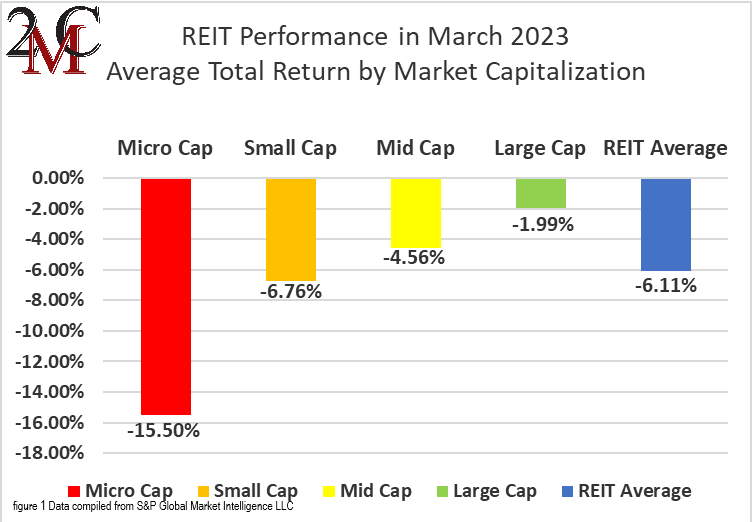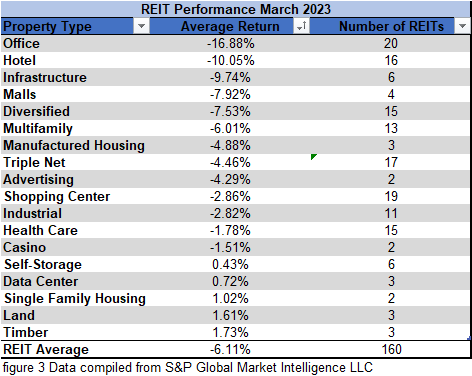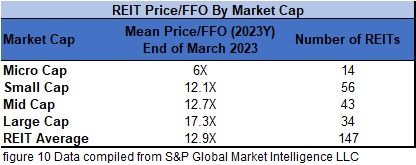The State of REITs: April 2023 Edition
- The REIT sector fell again in March with a -6.11% total return.
- Large cap (-1.99%) and mid cap (-4.56%) REITs saw modestly negative total returns in March, while small caps (-6.76%) and micro caps (-15.50%) were deeper in the red.
- Only 21.25% of REIT securities had a positive total return in March.
- Timber (+1.73%) and Land (+1.61%) REITs outperformed all other REIT property types in March. Office (-16.88%) and Hotel (-10.05%) REITs performed the worst, averaging double-digit declines.
- The average REIT NAV discount widened from -19.63% to -23.51% during March. The median NAV discount also widened from -17.59% to -22.22%.
REIT Performance
The REIT sector suffered another tough month in March (-6.11%) and fell into negative YTD return territory (-1.23%). REITs underperformed the Dow Jones Industrial Average (+2.08%), S&P 500 (+3.67%), and NASDAQ (+6.8%). The market cap weighted Vanguard Real Estate ETF (VNQ) had a much better total return than the average REIT in March (-2.18% vs. -6.11%) and is outperforming YTD (+1.66% vs. -1.23%). The spread between the 2023 FFO multiples of large cap REITs (17.3x) and small cap REITs (12.1x) narrowed slightly in March as multiples contracted by 0.2 turns for large caps and 0.1 turns for small caps. Investors currently need to pay an average of 43.0% more for each dollar of FFO from large cap REITs relative to small cap REITs. In this monthly publication, I will provide REIT data on numerous metrics to help readers identify which property types and individual securities currently offer the best opportunities to achieve their investment goals.
5 out of 18 Property Types Yielded Positive Total Returns in March
27.78% percent of REIT property types averaged a positive total return in March, with an 18.6% total return spread between the best and worst performing property types. Timber (+1.73%) and Land (+1.61%) were the best performing property types in March. Timber was buoyed by the strong performance of PotlatchDeltic (PCH) (+8.27%). All 3 Timber REITs are in the black after the first quarter of the year.
Office (-16.88%) and Hotel (-10.05%) REITs underperformed their REIT peers in March. In a painful repeat of February’s poor performance, all 20 Office REITs had negative total returns. All 20 Office REITs are now in the red year to date as well. Franklin Street Properties (FSP) (-35.12%), SL Green Realty (SLG) (-30.09%), and Office Properties Income Trust (OPI) (-25.18%) had the sharpest declines among Office REITs in March.
Performance of Individual Securities
iStar (STAR) merged with Safehold (SAFE) in a stock-for-stock transaction on March 31st. STAR shareholders received 0.153 shares of SAFE for every share of STAR held. This distribution of SAFE shares occurred after a reverse stock split in which each STAR share was consolidated into 0.160 shares. The combined entity will trade under the name Safehold and will continue to use the ticker SAFE.
Diversified Healthcare Trust (DHC) (+37.76%) was the best performing REIT again in March after leading the sector in February as well with a +23.83% total return. The share price of DHC soared after the REIT posted earnings on March 1st which handily beat the analyst consensus and the performance from the prior year.
Ashford Hospitality Trust (AHT) (-35.15%) was the worst performing REIT again in March with an even worse total return than their dismal -28.16% in February. This represents a continuation of the unrivaled share price decline of AHT, which has now fallen 99.5% in the past 5 years.
21.74% of REITs had a positive total return in March with 50.31% in the black year to date. During the first quarter of last year, the average REIT had a -1.44% return. During the 1st quarter of this year, the average REIT has had comparable performance with a -1.23% total return.
.

Dividend Yield
Dividend yield is an important component of a REIT’s total return. The particularly high dividend yields of the REIT sector are, for many investors, the primary reason for investment in this sector. As many REITs are currently trading at share prices well below their NAV, yields are currently quite high for many REITs within the sector. Although a particularly high yield for a REIT may sometimes reflect a disproportionately high risk, there exist opportunities in some cases to capitalize on dividend yields that are sufficiently attractive to justify the underlying risks of the investment. I have included below a table ranking equity REITs from highest dividend yield (as of 03/31/2023) to lowest dividend yield.

REIT Premium/Discount to NAV by Property Type
Below is a downloadable data table, which ranks REITs within each property type from the largest discount to the largest premium to NAV. The consensus NAV used for this table is the average of analyst NAV estimates for each REIT. Both the NAV and the share price will change over time, so I will continue to include this table in upcoming issues of The State of REITs with updated consensus NAV estimates for each REIT for which such an estimate is available.

Takeaway
The large cap REIT premium (relative to small cap REITs) narrowed slightly in March and investors are now paying on average about 43% more for each dollar of 2023 FFO/share to buy large cap REITs than small cap REITs (17.3x/12.1x – 1 = 43.0%). As can be seen in the table below, there is presently a strong positive correlation between market cap and FFO multiple.
Although REITs initially outperformed at the start of 2023, the total return of the REIT sector has now fallen far behind the total return of the S&P 500 year to date. This REIT underperformance is even more significant over the past years with REITs underperforming the S&P 500 by more than 1100 basis points.
The degree to which share buybacks are accretive is proportionate to the magnitude of NAV discount. Thus, it is appropriate that some of the most beaten down property types (such as Office, Multifamily, and Hotels) had among the largest volumes of share repurchases in 2022. It is also logical that property types trading at premiums to NAV such as Casino REITs had among the smallest volumes of buybacks.
The table below provides a list of equity REITs that have announced share repurchase plans. It is important to note that the announcement of such a plan does not guarantee that the maximum repurchase amount will be achieved or even that a REIT will execute any portion of the plan since the timing and quantity of repurchases will be heavily dependent upon market conditions. However, it does indicate that a REIT intends to capitalize on the mispricing of its own securities and provides a potential opportunity for NAV accretion.
It is always a very important part of due diligence to evaluate REIT balance sheets and to closely monitor capital management activities. However, which capital management activities a REIT should engage in is very different when at a favorable NAV premium vs. a large NAV discount. REIT management teams that are acting in the best interest of their shareholders will adjust their strategies according to market conditions and cost of capital and they will evaluate the opportunity cost of any decision. If there is a lack of alignment with shareholders, however, capital management activities may align more with executive compensation structure (for example assets under management (AUM)) and less with NAV/FFO accretion or balance sheet strengthening. The challenges and opportunities for REITs have changed dramatically since the end of 2021 when valuations for many REITs were inflated. Before investing in a REIT, investors would be wise to evaluate whether that REIT’s strategy appropriately reflects the current environment and whether its balance sheet is strong enough to successfully implement that strategy.
Important Notes and Disclosure
All articles are published and provided as an information source for investors capable of making their own investment decisions. None of the information offered should be construed to be advice or a recommendation that any particular security, portfolio of securities, transaction, or investment strategy is suitable for any specific person. The information offered is impersonal and not tailored to the investment needs of any specific person.
We cannot determine whether the content of any article or recommendation is appropriate for any specific person. Readers should contact their financial professional to discuss the suitability of any of the strategies or holdings before implementation in their portfolio. Research and information are provided for informational purposes only and are not intended for trading purposes. NEVER make an investment decision based solely on the information provided in our articles.
We may hold, purchase, or sell positions in securities mentioned in our articles and will not disclose this information to subscribers, nor the time the positions in the securities were acquired. We may liquidate shares in profiled companies at any time without notice. We may also take positions inconsistent with the information and views expressed on our website.
We routinely own and trade the same securities purchased or sold for advisory clients of 2MCAC. This circumstance is communicated to our clients on an ongoing basis. As fiduciaries, we prioritize our clients’ interests above those of our corporate and personal accounts to avoid conflict and adverse selection in trading these commonly held interests.
Past performance does not guarantee future results. Investing in publicly held securities is speculative and involves risk, including the possible loss of principal. Historical returns should not be used as the primary basis for investment decisions. Although the statements of fact and data in this report have been obtained from sources believed to be reliable, 2MCAC does not guarantee their accuracy and assumes no liability or responsibility for any omissions/errors
Commentary may contain forward-looking statements that are by definition uncertain. Actual results may differ materially from our forecasts or estimations, and 2MCAC and its affiliates cannot be held liable for the use of and reliance upon the opinions, estimates, forecasts, and findings in this article.
Through October 2021, The State of REITs was published exclusively on Seeking Alpha by Simon Bowler, Sector Analyst at 2nd Market Capital Services Corporation (2MCSC). Editions subsequent to October 2021 will be published on this website in addition to other platforms that may include Seeking Alpha. 2MCSC was formed in 1989 and provides investment research and consulting services to the financial services industry and the financial media. 2MCSC does not provide investment advice. 2MCSC is a separate entity but related under common ownership to 2nd Market Capital Advisory (2MCAC), a Wisconsin registered investment advisor. Simon Bowler is an investment advisor representative of 2MCAC. Any positive comments made by others should not be construed as an endorsement of the author's abilities to act as an investment advisor.
S&P disclosure: S&P Global Market Intelligence LLC. Contains copyrighted material distributed under license from S&P.













